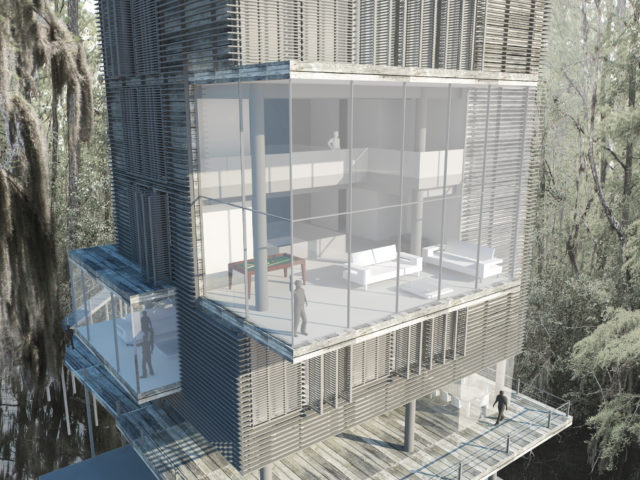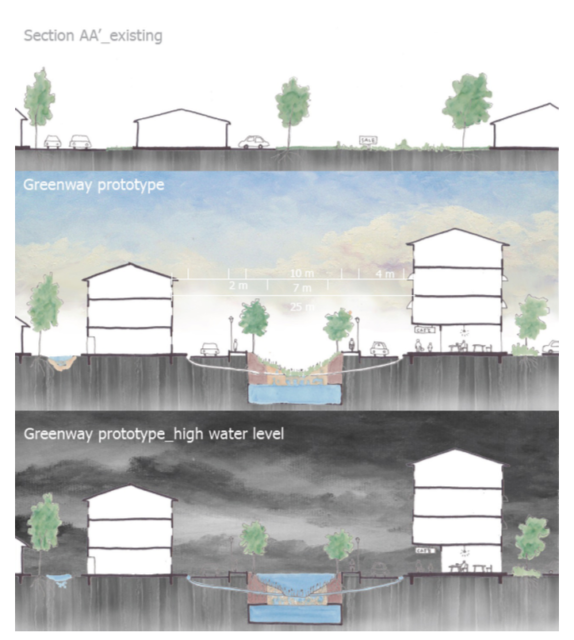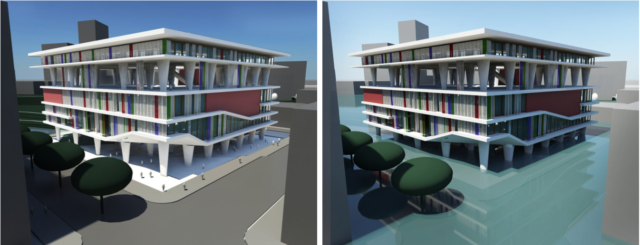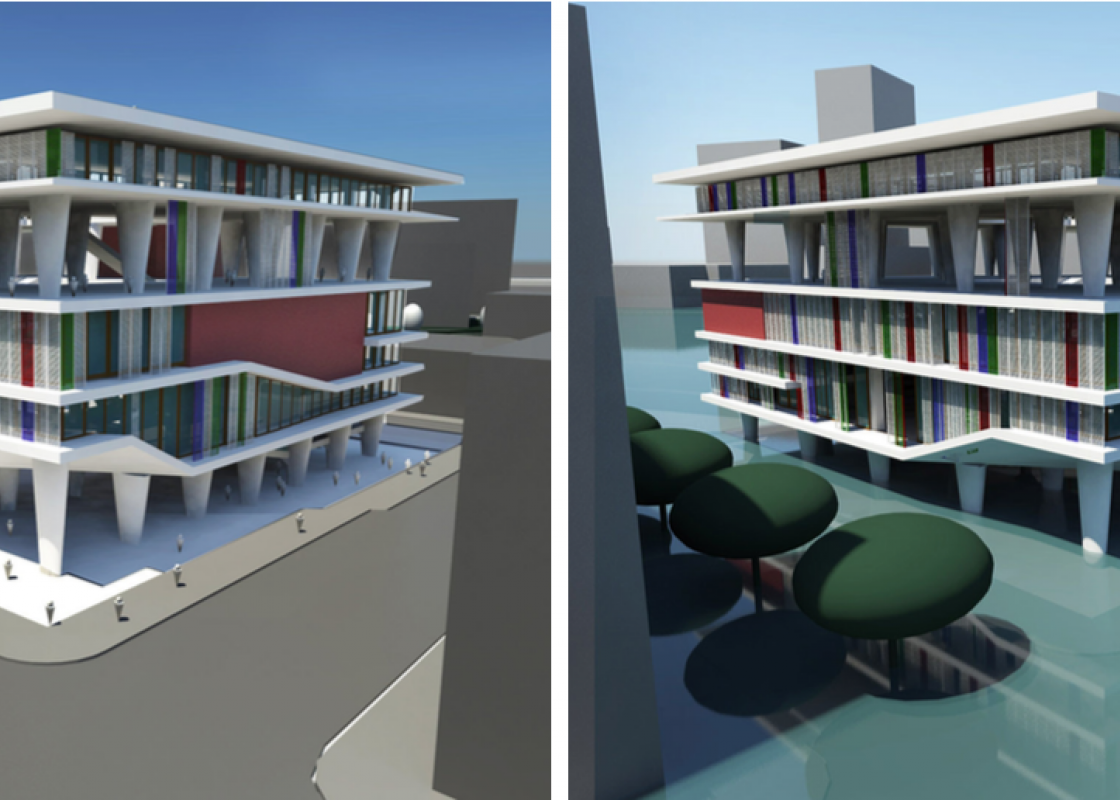This reflection by the late Thomas Colbert originally appeared in Delft Delta Design: The Houston Galveston Bay Region, a 2015 publication that came out of a collaboration of the University of Houston, Rice University, Texas A&M University in Galveston, and the Delft University of Technology in the Netherlands. This collaboration was spurred by the devastation of Hurricane Ike in 2008. Colbert comments specifically on the Delta Interventions Studio.
In June of 2014 it was my great good fortune to visit the Delft University of Technology to attend a review of student and faculty coastal planning research and design work including, to my great delight, a brilliant presentation by one of the recently announced finalists for the international Rebuild By Design competition. After a full afternoon with the students and faculty, I was greatly impressed by the range and thoughtfulness of responses to the challenge of protecting urban areas against flooding, while making cities and urban regions better places to live. When I then heard that the Houston Galveston Bay Region had been selected as the subject for the 2015 Delta Interventions Studio I couldn’t have been more delighted. I imagined the same talent that I had just witnessed being directed at my own region, where the threat of flooding and the need for coastal and spatial planning couldn’t be greater. I was not to be disappointed. As you have seen in the previous pages of this book, an impressively diverse range of thoughtful research and well-developed design projects has been put forward in only two semesters.
 Student design for a birding watchtower. Courtesy Thomas Colbert.
Student design for a birding watchtower. Courtesy Thomas Colbert.
The Houston Galveston Bay Region is an especially challenging and deserving subject for such a studio. The region is highly susceptible to hurricane-related tidal surge and rainwater flooding from tropical storms. Its rapidly growing metropolitan area contains approximately six million people, the most important international port in the United States, and perhaps the largest collection of petrochemical refining, storage, and transmission networks in the world, and yet it is almost completely unprotected against flooding hazards either by land use planning or structural measures. The reason for this apparent failure of reason is the State of Texas’ radical devotion to the idea that less is more where government is concerned, combined with protracted political squabbles about what to do. In short, we have been too busy arguing to look the problem squarely in the face.
 Section of a street before and after an intervention addressing flood mitigation, walkability, and density. Courtesy Song-Ya Huang.
Section of a street before and after an intervention addressing flood mitigation, walkability, and density. Courtesy Song-Ya Huang.
While studios in Texas and Louisiana have examined these issues on a regular basis, the Delta Interventions Studio has brought unique resources to bear on the problem. The most important of these resources are a completely fresh and well-informed international perspective and a profoundly well-integrated multi-disciplinary point of view and team structure. Independence from any association with the politics of our region combined with familiarity with a wide range of historical precedents for these problems is extremely important as well. But, it is the depth of integration of diverse disciplines that is the most unique aspect of this the Delta Interventions Studio and the one that seems most responsible for the extraordinary diversity of solutions that were proposed for Galveston Bay.
It is no longer so unusual in university settings for disciplinary silos to be broken down in applied research teams. Subjects as complex as coastal and spatial planning require it. Hydrology and other aspects of civil engineering, urban planning and architecture, environmental and political sciences are all essential to the field. Even geophysics is foundational for this essentially multi-disciplinary field. In the United States, in studios, lecture and seminar courses it is possible, although still quite unusual, to engage smaller groups of multi-disciplinary faculty in coursework; however, it is almost unheard of for a graduate design studio to incorporate so many diverse faculty and students from different disciplines working together. To have so many distinguished faculty from different branches of Engineering, Architecture, Urbanism, and Technical Policy and Management working together with a team of students pursuing degrees in coastal engineering, architecture, urbanism, and systems engineering and policy analysis is a remarkable academic and pedagogic achievement.
The result of this collaboration, under the able leadership of Anne Loes Nillesen, has been the impressively wide range of projects that are recorded in this book. Each project taken on its own provides an independent and well-informed look at the problems and opportunities facing the Houston Galveston Bay Region. From proposals for the development of flood-resilient social housing along a tributary bayou to spatial planning for a barrier island, and building with natural measures inside Galveston Bay, we are given a new understanding of the region. Taken together this collection of projects provides us with a fresh vision of the region — one that is independent of political debates and that concentrates on opportunities as much as problems.
 Leisure Center proposal for Downtown Houston. Courtesy Kito Sampson.
Leisure Center proposal for Downtown Houston. Courtesy Kito Sampson.
The problems of rainwater and surge tide flooding in the Houston Galveston Bay Region are unprecedented in their scale and complexity. It seems apparent that no single answer to these problems will be adequate to that challenge. Rather, multiple answers must be found, each operating at different scales and with different implementation mechanisms. Since it is clear that many of the answers to these challenges are not yet dreamed of, what is needed by the professional, political, and academic communities of the Houston Galveston Bay Region is informed speculation about land use and architecture as mitigation tools. This will stimulate creative debate, help to unearth new ideas, and permit convincing strategies to be developed.
Using design as a research tool, the Delta Interventions Studio has made a substantial contribution to the understanding of the Galveston Bay Region, an understanding that may well play an important role in the development of solutions to the many pressing problems we are facing. Who knows which of these design proposals may influence future decision-making? In any case, the studio has made a substantial contribution to graduate level teaching and pedagogy. By bringing together so many disciplines at such a high level, including faculty and students who were involved in this two-semester program, it has set a high standard for multi-disciplinary education, one that is likely to be emulated in universities around the world.
Thomas Colbert was a professor at the Gerald D. Hines College of Architecture at the University of Houston, Texas. He also served as the chair of the Cite editorial committee, guest edited several issues, and was a frequent contributor.
Further Reading
Mihalic, Falon. "Houston Flood Management, A Literature Review: What We Know and Where We Go from Here." OffCite.org. October 17, 2017.
Mankad, Raj. "A Proposal for Birdwatch Towers along Galveston Bay." OffCite.org. April 14, 2014.










